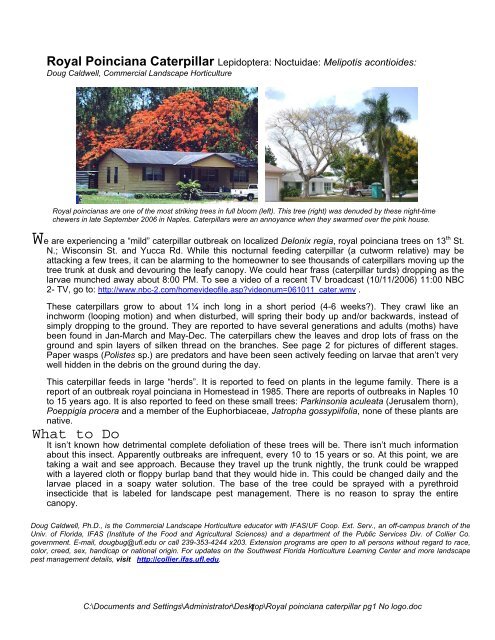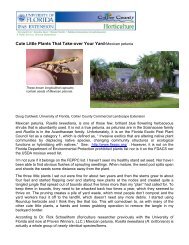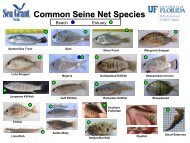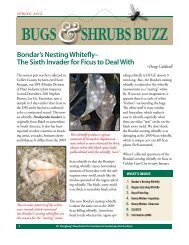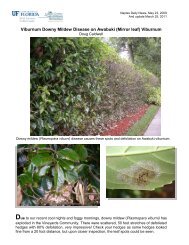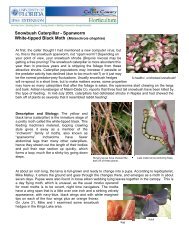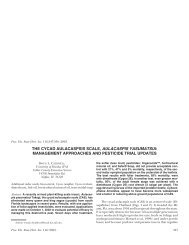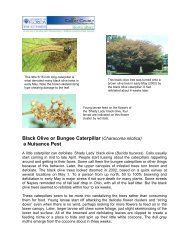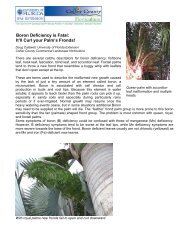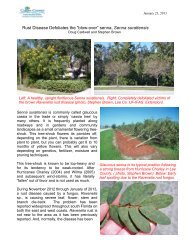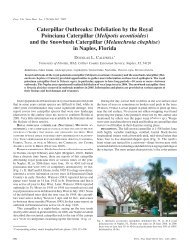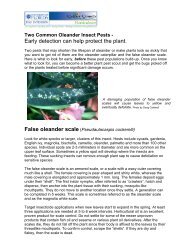Royal Poinciana Caterpillar
Royal Poinciana Caterpillar
Royal Poinciana Caterpillar
Create successful ePaper yourself
Turn your PDF publications into a flip-book with our unique Google optimized e-Paper software.
<strong>Royal</strong> <strong>Poinciana</strong> <strong>Caterpillar</strong> Lepidoptera: Noctuidae: Melipotis acontioides:<br />
Doug Caldwell, Commercial Landscape Horticulture<br />
<strong>Royal</strong> poincianas are one of the most striking trees in full bloom (left). This tree (right) was denuded by these night-time<br />
chewers in late September 2006 in Naples. <strong>Caterpillar</strong>s were an annoyance when they swarmed over the pink house.<br />
We are experiencing a “mild” caterpillar outbreak on localized Delonix regia, royal poinciana trees on 13 th St.<br />
N.; Wisconsin St. and Yucca Rd. While this nocturnal feeding caterpillar (a cutworm relative) may be<br />
attacking a few trees, it can be alarming to the homeowner to see thousands of caterpillars moving up the<br />
tree trunk at dusk and devouring the leafy canopy. We could hear frass (caterpillar turds) dropping as the<br />
larvae munched away about 8:00 PM. To see a video of a recent TV broadcast (10/11/2006) 11:00 NBC<br />
2- TV, go to: http://www.nbc-2.com/homevideofile.asp?videonum=061011_cater.wmv .<br />
These caterpillars grow to about 1¼ inch long in a short period (4-6 weeks?). They crawl like an<br />
inchworm (looping motion) and when disturbed, will spring their body up and/or backwards, instead of<br />
simply dropping to the ground. They are reported to have several generations and adults (moths) have<br />
been found in Jan-March and May-Dec. The caterpillars chew the leaves and drop lots of frass on the<br />
ground and spin layers of silken thread on the branches. See page 2 for pictures of different stages.<br />
Paper wasps (Polistes sp.) are predators and have been seen actively feeding on larvae that aren’t very<br />
well hidden in the debris on the ground during the day.<br />
This caterpillar feeds in large “herds”. It is reported to feed on plants in the legume family. There is a<br />
report of an outbreak royal poinciana in Homestead in 1985. There are reports of outbreaks in Naples 10<br />
to 15 years ago. It is also reported to feed on these small trees: Parkinsonia aculeata (Jerusalem thorn),<br />
Poeppigia procera and a member of the Euphorbiaceae, Jatropha gossypiifolia, none of these plants are<br />
native.<br />
What to Do<br />
It isn’t known how detrimental complete defoliation of these trees will be. There isn’t much information<br />
about this insect. Apparently outbreaks are infrequent, every 10 to 15 years or so. At this point, we are<br />
taking a wait and see approach. Because they travel up the trunk nightly, the trunk could be wrapped<br />
with a layered cloth or floppy burlap band that they would hide in. This could be changed daily and the<br />
larvae placed in a soapy water solution. The base of the tree could be sprayed with a pyrethroid<br />
insecticide that is labeled for landscape pest management. There is no reason to spray the entire<br />
canopy.<br />
Doug Caldwell, Ph.D., is the Commercial Landscape Horticulture educator with IFAS/UF Coop. Ext. Serv., an off-campus branch of the<br />
Univ. of Florida, IFAS (Institute of the Food and Agricultural Sciences) and a department of the Public Services Div. of Collier Co.<br />
government. E-mail, dougbug@ufl.edu or call 239-353-4244 x203. Extension programs are open to all persons without regard to race,<br />
color, creed, sex, handicap or national origin. For updates on the Southwest Florida Horticulture Learning Center and more landscape<br />
pest management details, visit http://collier.ifas.ufl.edu.<br />
C:\Documents and Settings\Administrator\Desktop\<strong>Royal</strong> 1 poinciana caterpillar pg1 No logo.doc
Full grown larva ready to go shopping (above).<br />
Larvae on trunk 20 minutes after sunset (right).<br />
Adult of Melipotis acontioides, the royal poinciana<br />
caterpillar. Photo by Jim Vargas purloined from:<br />
http://mothphotographersgroup.msstate.edu/Files/Live/Species/<br />
8000/8610.shtml<br />
2737 13 th St. N on October 5, 2006.<br />
C:\Documents and Settings\Administrator\Desktop\RPmoth2.doc<br />
Doug Caldwell<br />
IFAS/UF<br />
Collier Co.<br />
Oct. 2006<br />
<strong>Caterpillar</strong>s congregated on trunk; note webbing along<br />
right side of trunk. All of the dark spots are dead<br />
larvae (below), that were possibly sprayed with an<br />
insecticide.


